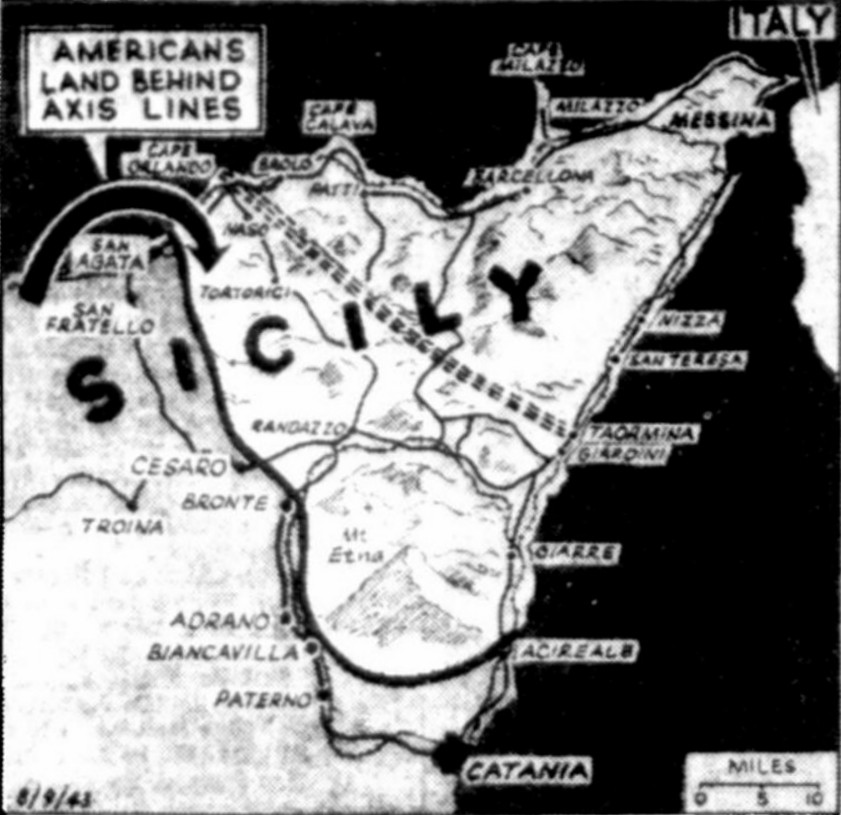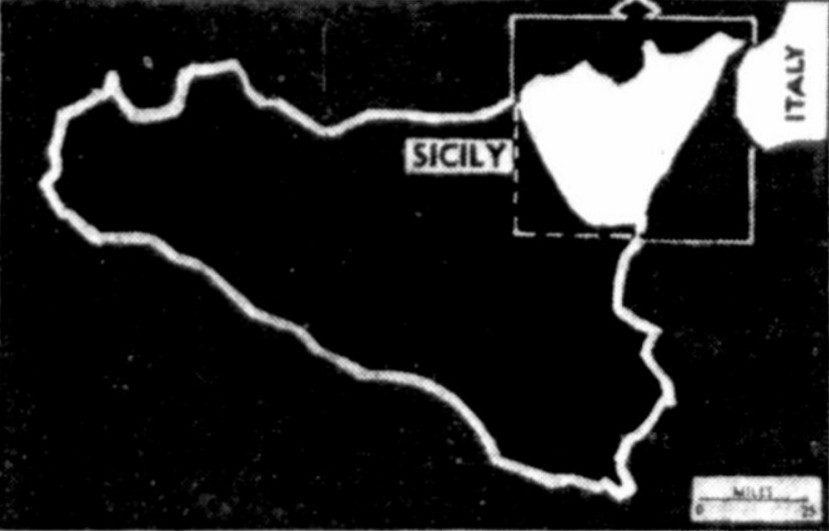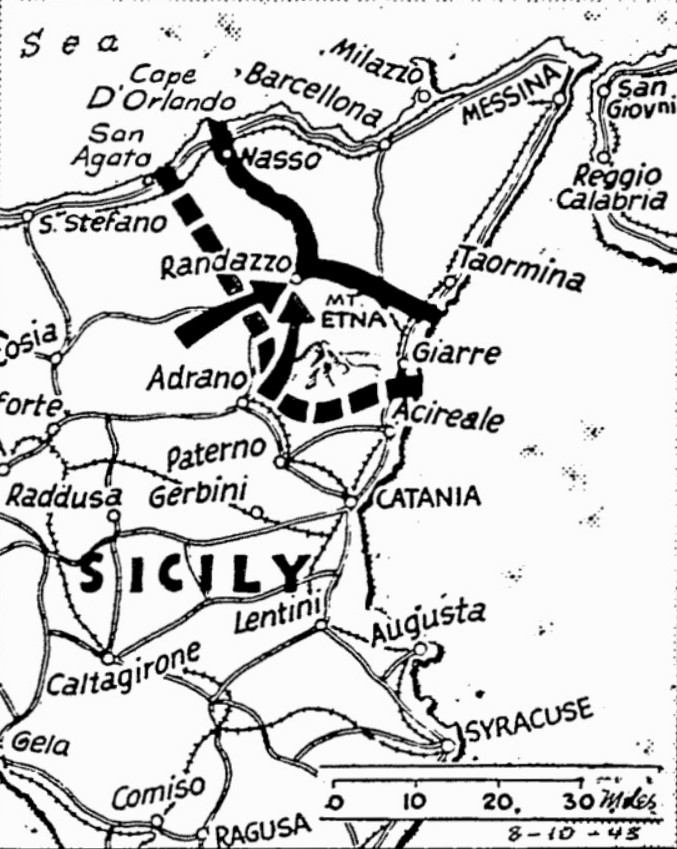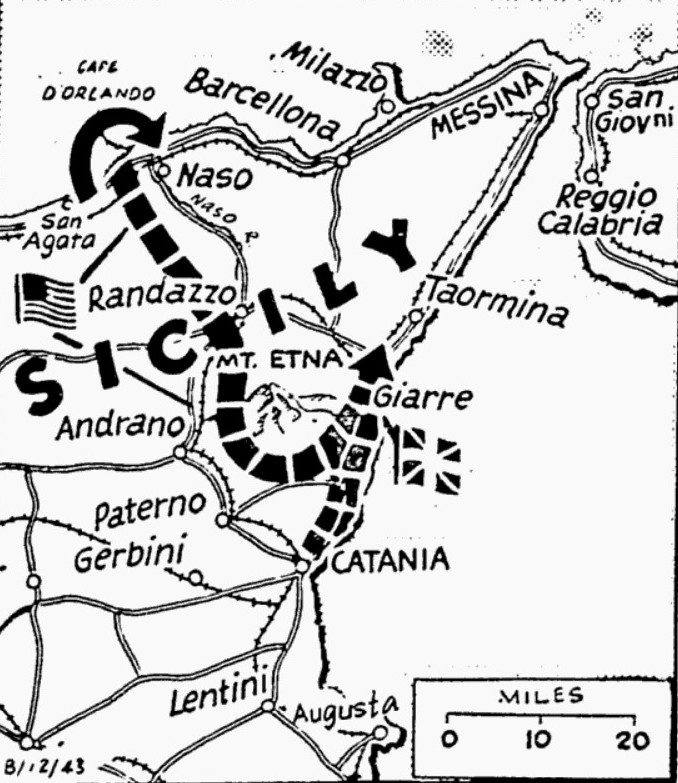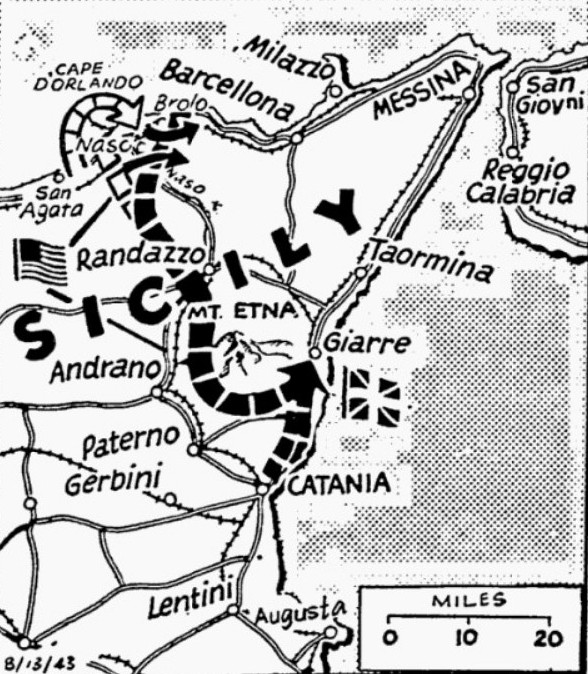The Pittsburgh Press (August 11, 1943)
8th Army and Yanks join at vital pass, push ahead despite Nazi demolition tactics; shores of Italy sighted
By Virgil Pinkley, United Press staff writer
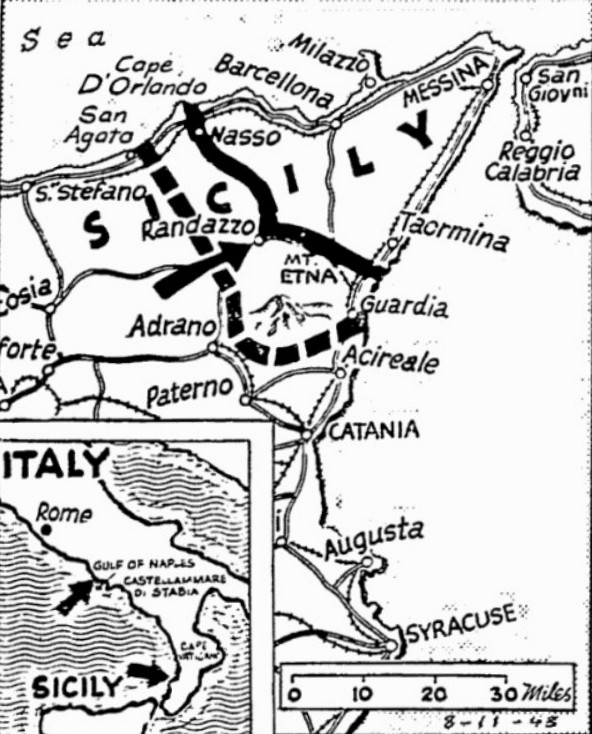
Driving up the coast of Sicily, the British 8th Army has captured Guardia at the end of the Allied advance line on the island (broken line). Allied troops drove toward Randazzo (arrow), the center of the Axis prepared defenses (solid line). British warships moved into the Gulf of Naples to shell the Castellammare di Stabia naval yards, and also bombarded railway bridges at Cape Vaticano, on the instep of the Italian boot (lower left map).
Allied HQ, North Africa –
British warships, steaming one-third of the way up the Italian west coast, bombarded a naval yard in the Gulf of Naples while Allied ground forces pounded along the Sicilian coast to within sight of the Italian mainland, it was announced today.
One British 8th Army column captured Guardia in a two-to-three-mile advance along the east coast road bordering Mt. Etna and came within sight of the toe of the Italian boot for the first time. Only 14 miles to the north lay the Axis base of Taormina.
Other 8th Army forces consolidated their junction with the U.S. 7th Army north and west of Bronte, 22 miles to the northwest, in a general advance toward Randazzo Pass, controlling the last good road between the Sicilian east and north coasts.
Sea control asserted
Gen. Dwight D. Eisenhower’s communiqué said:
Progress continues to be made whilst our troops overcome enemy resistance and deal with obstacles he is having.
A strong force of British cruisers and destroyers boldly asserted the Allied command of the sea and air around Italy by steaming up the west coast to the Gulf of Naples Monday night and sending a stream of shells into the Castellammare di Stabia naval shipbuilding and repair yard only 20 miles southeast of Naples.
It marked the deepest penetration yet of Italian waters and carried the British naval forces more than 200 miles north of Palermo.
Allied advance slowed
Simultaneously, another Allied naval force shelled railway bridges at Capo Vaticano on the instep of the Italian boot below the Gulf of Saint Eufemia, over which Italian military trains for southern Italy must move.
The Allied advance toward Randazzo on the northwestern slope of Mt. Etna was in the face of fierce resistance, including murderous mortar bombardments from German guns mounted on heights commanding roads from Bronte and Cesarò.
The British and Americans were also slowed by extensive enemy demolitions. Blasted roads and bridges enforced halts of several hours while sappers and bulldozers filled in the craters and built makeshift bridges.
Germans face trap
Of the 120,000 prisoners announced yesterday as in Allied hands, the U.S. 7th Army captured 92,000 and the British 8th Army 28,000. It has not been specified who took the 5,000 prisoners who have since been taken.
A British broadcast heard by CBS placed the Americans within two miles of Randazzo, but emphasized that the report had not been confirmed.
The fall of Randazzo would put Italo-German armies in their worst predicament since the Allies blasted through the Tunis plain and swarmed onto the Cape Bon Peninsula in May.
British and U.S. bombers continued to concentrate to concentrate their cargoes on Axis transport clogging the roads running north and northeast from Randazzo toward the evacuation ports of Messina and Milazzo.
Planes in action
Other planes kept up constant patrols over Messina Strait to break up evacuation attempts.
An Italian communiqué reported that Messina was “intensely and repeatedly bombed.”
On the north coast, the U.S. 7th Army consolidated the positions reached in the successful landing at the mouth of the Rosmarino River some 45 miles west of Messina.
A German broadcast said that a violent Axis artillery barrage thwarted fresh American landing attempts east of Sant’Agata on the north coast.
Mainland in sight
The advance to within sight of the Italian mainland was made by the British troops moving up the east coast. From a vantage post on the side of Mt. Etna the British could see, some 35 miles distance, the Italian promontory known as Capo dell’Armi, where there is a small fighting village of the same name.
They could also see, looming up in the distance behind this point, the 6,000-foot Aspromonte Range.
The 8th Army advance netted the important communications point of Guardia, where the Messina-Catania highway swings inland for several miles. The area also has four railroad tunnels.
Messina bombed, Italians say
London, England (UP) –
Messina, on the eastern corner of Sicily, was “intensely and repeatedly” bombed by Allied air forces yesterday, an Italian communiqué broadcast by Radio Rome said today, and Axis troops are engaged in “hard defensive” fighting on the island.
Italian torpedo planes were said to have damaged an Allied light cruiser and two medium-sized vessels off Sicily last night.
A supplementary announcement said 124 persons were killed and 352 wounded in recent air raids on Turin, Milan and Genoa.
Germans claim hits on ships
London, England (UP) –
German bombing planes in attacks on Allied-held Sicilian ports hit and damaged 16 vessels, including a large warship and a destroyer, in attacks yesterday and last night, a German communiqué broadcast by Berlin radio said today.
The communiqué said vaguely that Allied attacks were repulsed in Sicilian land fighting.
Admitting local Soviet breakthroughs south and southwest of Vyazma on the Russian front. The communiqué said 348 Soviet tanks were destroyed yesterday, including 61 near Belgorod.
Fourteen bombers were said to have been shot down over Nuremberg last night during an air raid which caused some damage to residential and public buildings.
